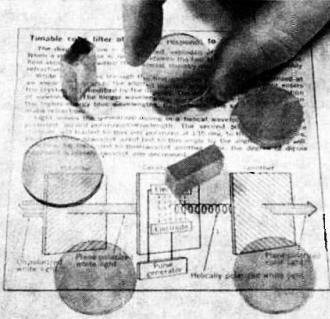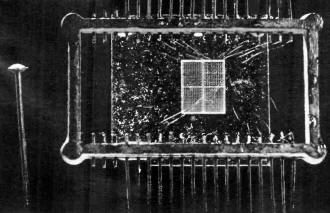Transparent Ceramics for Electro-Optics
|
|
Every time I see something about "transparent anything" that formerly was know only in an opaque form, I think about the Star Trek "The Voyage Home" movie (click on the link if you don't know what I mean). This transparent ceramic material was a real breakthrough in optics technology in its day due to the ability to control its degree of transparency or opacity with an electric field. It would even retain its state with the electric field removed so use as a data or even image storage device was possible. An ability to be quickly switched (at up to a 10 MHz rate) held promise for it as a laser or other light source modulator or even as a high speed facsimile (fax) system. It seems sort of like a solid version of a liquid crystal display (LCD). Lots of unique optics terms appear in this article, so I provided hyperlinks to them for you. Transparent Ceramics for Electro-Optics
By Nigel S. Hey Sandia Laboratories Electro-Optical devices have been in use for quite a number of years, from Edison's first incandescent light bulb to modern light-emitting diodes and research dye lasers. Simply by closing a switch, these devices operated exactly as they were designed to. However, in the attempt to modify the light after these devices are turned on, problems begin to appear. To solve the problems of light processing, Sandia Laboratories in Albuquerque, New Mexico, has developed a new ceramic device which offers an alternative to traditional Kerr and Pockels cells and other mechanical contrivances. The new ceramic is similar to that used as the piezoelectric transducer in phonograph pickups. The big difference is that the new ceramic - hot-pressed and doped with lanthanum, a metallic rare-earth element - is transparent. When sandwiched between crossed polarizers, the lanthanum-modified lead zirconate-lead titanate (PLZT) ceramic acts as a variable color filter or transmits light intensity in response to an applied voltage. Used in a "scattering" mode, it displays black and white images without the need for polarizers. Most important, PLZT has a built-in memory.
Positive image stored in a ceramic electro-optic device. Plate is 1 in. in diameter and is 0.0123 in. thick. At least a minor revolution in electro-optic technology is promised by PLZT. The ceramic can be used to modulate lasers for communication purposes; extract colors from white light; store information in binary or decimal form; turn on and off light beams; and store and display images. Variations of PLZT are suited to special applications like high-contrast shutters or memories which retain stored information until erased. How It Works Let us take a microscopic look at PLZT. The material consists of randomly spaced PLZT "crystallites," in which each unit cell is arranged like a cube with lead and lanthanum ions at the corners, oxygen ions in the center of each face, and a titanium or zirconium ion in the center of the cube. In this configuration, both the unit cell and the crystallite are electrically neutral. But in "slim loop" PLZT, the central titanium or zirconium ion is displaced toward one of the oxygen ions when an electric field is applied. The unit cell distorts into a tetragon and becomes an electric dipole. Clusters of unit cells align in the same direction to form a domain dipole. Increasing the electric field increases both the magnitude and alignment of the domain dipoles. When the electric field is removed, the domain dipoles disappear and the ceramic returns to its electrically and optically isotropic state. In ferroelectric or "wide loop" PLZT, the unit cell is spontaneously distorted, causing domain dipoles to exist with no applied electric field. When an electric field is applied, it causes domains favorably aligned with respect to the field to grow at the expense of others and produces increased domain alignment. Controllable dipole alignment is the basis of PLZT's remarkable versatility. This alignment determines whether or not the material is birefringent (high or low double refraction) and the magnitude of the birefringence. In another Mode of operation, dipole alignment controls the ceramic's light-scattering properties. Birefringence has the effect of changing the polarization of plane-polarized light. By controlling birefringence, one can also control the amount or color of light penetrating a polarized filter. Hence, PLZT can be said to be a solid-state analog of the Kerr cell which exhibits a quadratic electro-optical effect. Alternatively, using a different chemical mixture, PLZT exhibits a linear electro-optical effect similar to a Pockels cell. Unlike the Kerr cell. PLZT is solid-state and compact. It is less expensive to make and has a much larger electro-optical effect than does potassium dihydrogen phosphate (KDP) and lithium niobate crystals commonly used in Pockets cells. For the same applied voltage, 12 times the effect of KDP is produced by one composition of PLZT. Electro-Optical Memory These variously shaped electro -optic ceramic pieces, made by new process, are very transparent and homogeneous. Prototype of ceramic memory element can store 5120 bits/sq.in. Straight pin at left. The one feature of PLZT that is unique is its electro-optical memory. When the polarizing electric field is removed from "wide loop" PLZT, the domain dipoles do not return to a random orientation. The ceramic remains birefringent and stays this way until changed by electrically reorienting the dipoles. The dipoles can be returned to a random orientation by raising the temperature of the PLZT to its Curie point. In PLZT materials; the applied field-versus-birefringence plot follows a hysteresis curve. Typically, memory-type PLZT exhibits a certain maximum retardation (saturation) while the field is applied. When the field is removed, tire material relaxes into a remanent (residual) state with a lesser birefringence. Subsequent electric field pulses can be used to switch the ceramic into other remanent states. Device Applications Many device applications present themselves when one considers the effect from a relatively simple device consisting of an electroded ceramic slice sandwiched between crossed polarizers. These include: Memory material - light gates and shutters; optical memories which can he read without photocell arrays; controlled-persistence displays and electrically controlled spectral filters. For color effects, back lighting with plane-polarized light is used. Each frequency component of white light is affected by birefringence. By applying a specific voltage to the material, one color can he made to dominate as light penetrates the analyzer. Monochromatic light is used to achieve "amplitude modulation." Pockets - effect material-linear light modulation and momentary light shutters. This material could be useful in modulating laser beams at frequencies up to approximately 10 MHz. Kerr-effect material - quadratic light modulators and light shutters. This is an extremely promising material since it is para-electric at room temperature and, thus, optically isotropic. Virtually no light passes through the crossed polarizers of the device. When a field is applied, however, the crystallites distort and the ceramic becomes birefringent. When the field is removed, the material immediately relaxes to a para-electric state. Longitudinal-Mode Ceramic So far, devices in which an electric field is applied perpendicular to the direction of light propagation (transverse mode) have been discussed. But one major development has been pioneered at Sandia in which the field and light are applied in the same direction (longitudinal mode). The new device is called Cerampic. In Cerampic, no birefringence is involved. The device works entirely by scattering light. Dark areas of the image scatter more light away from the viewing plane than do light areas. Non-image forming scattered light is then removed from the projected light beam with a contrast-enhancing pinhole aperture. To make Cerampic, one side of a PLZT ceramic slice is coated with photoconductive polyvinyl carbazole (PVK). The device is then coated on both sides with transparent electrodes. High-resolution images (up to 1000 line pairs/inch) are stored in this device by illuminating it with light through a photographic negative or with a scanning light beam while applying voltage to the electrodes. Light passing through the negative penetrates the transparent electrode and enters the PVK, decreasing electrical resistivity anti allowing current to pass through the ceramic to the second transparent electrode. In this manner, the relative opacity (or scattering capability) of innumerable points on the ceramic plate is altered so that the device transmits various shades of gray in the form of an image. The image has memory, is erasable, and can be viewed directly or projected like a 35-mm slide. A variety of potential uses is possible with Cerampic. Most promising is the generation of images from signals received by telephone or radio. These images could be generated in a few seconds or, conceivably, at rates of up to 15,000 lines/second. Cerampic is being considered for use in optical information storage and processing systems. The new scattering effect may also prove useful in devices such as shutters, optical memories, and page composers for holographic memories. Many companies are now working on devices that use PLZT as the basic working medium. Since the material was developed by Sandia Laboratories under a prime Atomic Energy Commission contract, the basic work is covered by patents held by the U.S. Government. This means that private companies may be licensed to develop and use the material on a no-royalty, revocable. nonexclusive basis.
Posted October 1, 2019 |
|




